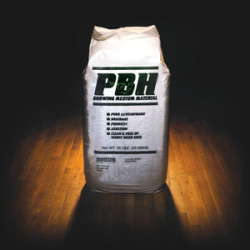Lightweight Champion

PBH’s size, shape and bulking properties produce optimum air-filled pore space, water-holding capacity and drainage for greenhouse and container production. It can be blended with peat, bark and coir to produce substrates suitable for a wide range of growing requirements.
Because PBH is lightweight and compressed when packaged, it requires less storage space and reduces handling and freight costs. It is uniquely processed to ensure purity and is sized, cleaned and subjected to a series of heat treatments that sterilize the rice hulls and render any residual rice kernels, weed seed or disease pathogens non-viable. Minimal dust improves the mixing environment.
“Our employees really like that it is less dusty, and because of the compressed bale, there is less handling,” says Jim White, owner of White’s Greenhouse in Godfrey, Ill. “I like that the compressed bales require less storage space. I can have more material on hand with less space in the greenhouse used and fewer bags to throw in the trash.”
Growers should evaluate various component percentages to determine the optimum growing media mix to meet individual cultural conditions and growth requirements. The following information is intended to help insure proper use of PBH:
– Recommended PBH use rate is 10 to 30 percent of total growing media.
– The desired minimum air-filled pore space in a 4- or 6-inch container is 10 to 15 percent.
–Growing media with 20 percent PBH has approximately 10 percent air-filled pore space.
–Growing media with 30 percent PBH has approximately 20 percent air-filled pore space.
–The higher the PBH ratio, the lighter the growing media will be and the better the container will drain.
–Add PBH last when mixing growing media.
–When replacing another component with PBH, always conduct side-by-side comparisons to determine desired growing media characteristics.
–When replacing perlite, begin by using 5 to 10 percent less PBH.
–If the resulting growing media is too heavy and does not adequately drain, increase the PBH percentage.
–If the resulting growing media is too light and drains too quickly, reduce the PBH percentage.
–PBH has a 6.2 to 6.6 pH range.
–PBH provides less than 1 percent nitrogen, phosphorus and potassium. Fertilize accordingly.
–PBH does not contain fluoride.
–PBH is a natural material that will decompose over time, but not during a typical production cycle of greenhouse or container-grown nursery stock.
Melinda Rudd, greenhouse manager for Ernst Conservation Seeds in Meadville, Pa., says she has seen more rapid and vigorous development of root growth, root balls and root hairs since incorporating PBH. “The root hairs are a good indicator that the plant will establish more quickly when planted,” says Rudd.
For more information on PBH, visit www.riceland.com.









